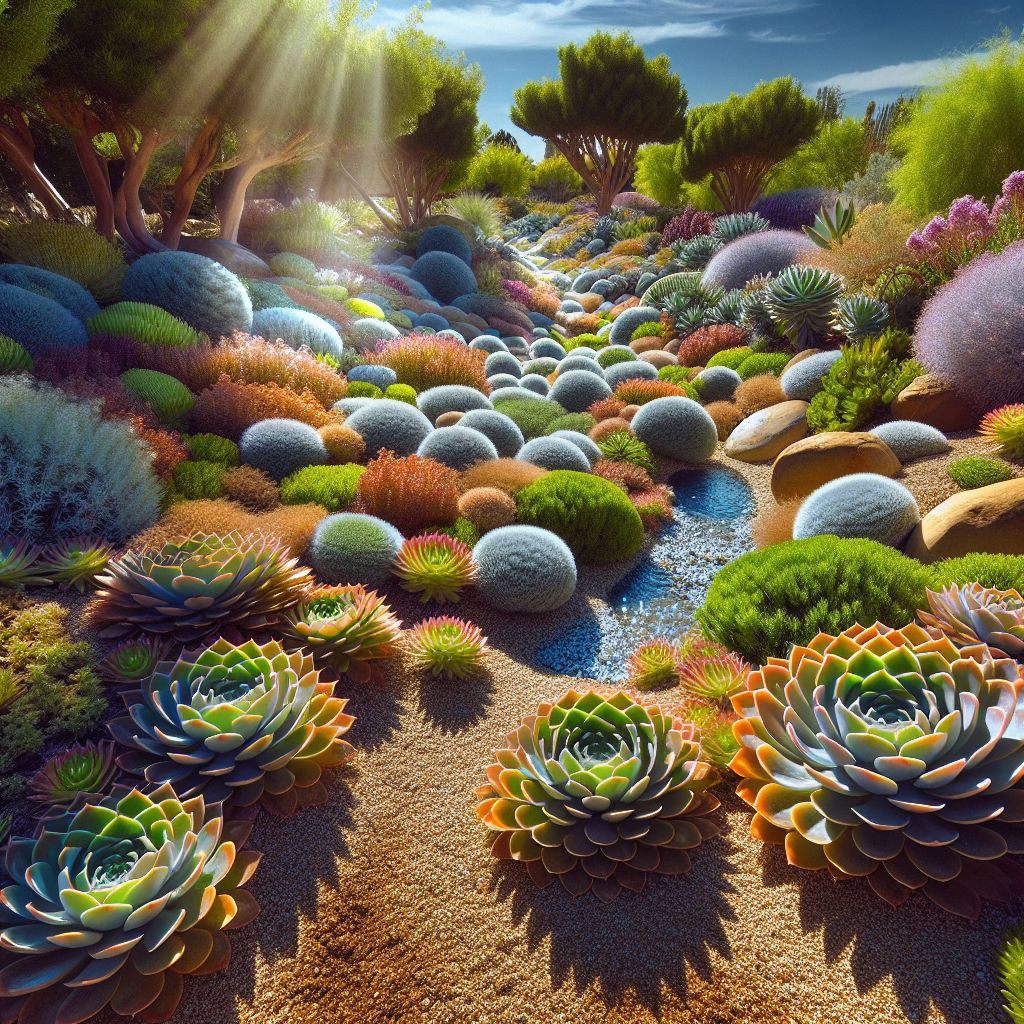
Key Takeaways
- Xeriscaping is a landscaping method that reduces the need for irrigation by using drought-tolerant native plants.
- In Ohio, native plants like Purple Coneflower and Black-eyed Susan thrive with minimal water and care.
- Designing a xeriscape involves careful planning, soil preparation, and choosing the right plants for your specific environment.
- You can create a beautiful and sustainable garden that supports local ecosystems by grouping plants with similar water needs.
- Adopting
practices saves water and reduces maintenance time and costs.
Green Up Your Yard: The Ohio Xeriscaping Guide
Imagine your garden vibrant with color, buzzing with pollinators, and thriving, all while slashing your water bill and upkeep chores. That’s the power of xeriscaping, a gardening philosophy that harmonizes with nature rather than working against it. Let’s dive into how you can turn your Ohio yard into a low-maintenance, eco-friendly oasis.
Why Xeriscaping is the Green Choice for Ohio
Ohio’s weather can be unpredictable, with dry spells in the summer and wet springs. Xeriscaping is a smart response to these conditions, allowing you to cultivate a resilient landscape that can withstand the fluctuations. It also taps into the beauty of native flora, which naturally suits the local climate and soil, reducing the need for supplemental watering and chemical fertilizers.
Therefore, embracing xeriscaping means you’re not just designing a garden; you’re crafting an ecosystem that supports local wildlife and conserves precious resources. It’s a proactive step towards a more sustainable lifestyle that anyone with a patch of land can take.
Benefits of Embracing Native Plant Diversity
Native plants are the unsung heroes of the eco-gardening world. They’ve spent millennia adapting to Ohio’s climate, making them tough as nails regarding weather extremes. Most importantly, they offer a smorgasbord of benefits:
- Water Efficiency: They’ve mastered surviving on what nature provides, meaning less watering on your part.
- Low Maintenance: They’re used to the local pests and diseases, requiring less babysitting.
- Biodiversity: Native plants are like the favorite restaurants of local wildlife. They attract a variety of pollinators, birds, and beneficial insects.
And because they’re so in tune with the local environment, they can actually improve the health of your soil and the air around your home. It’s like your garden is giving Mother Nature a helping hand.
Foundational Elements for Xeriscaping in Ohio
The Right Plants for the Right Places
The mantra of xeriscaping is “right plant, right place.” This simply means matching plants to the conditions they love. For instance, if you’ve got a sunny spot that dries out faster than a raindrop in the desert, plant species that soak up the sun and scoff at drought. Do you have an area that’s shady and cool? There are natives that thrive there, too.
It’s all about working with the hand you’ve been dealt by nature, rather than fighting it. This approach leads to a garden that’s beautiful and practically takes care of itself.
Soil Preparation: The Bedrock of Xeriscaping
Good soil is the bedrock of any garden, but it’s especially crucial in xeriscaping. You want to create an environment where water is retained efficiently, and nutrients are plentiful. This often means amending your soil with organic matter, which improves its structure and water-holding capacity.
Remember, healthy soil equals healthy plants, and healthy plants need less from you in terms of water, fertilizer, and fuss. It’s a win-win-win situation.
Grasses and Groundcovers: The Carpet of Your Garden
Grasses and groundcovers are the unsung heroes of the xeriscape garden. They provide a lush, green backdrop to your more flamboyant flowers and serve a practical purpose, too. Groundcovers, such as creeping thyme and
Building Your Xeriscaping Plan
So, you’re ready to transform your Ohio yard into a xeriscape? Great! Start with a plan considering your local climate, soil type, and sun exposure. Sketch out your garden, noting areas of full sun, partial shade, and full shade. This will guide you in selecting the right plants for each area. Don’t forget to consider the mature size of plants to avoid overcrowding and to promote good air circulation.
Design Principles for Water Conservation
When it comes to xeriscaping, water conservation is key. Start by reducing lawn areas, which guzzle water, and replace them with drought-resistant native plants. Group plants with similar water needs together – this is called hydrozoning. It’s a smart move that ensures you’re only using water where and when it’s needed.
Another water-wise tip is to incorporate a rain garden into your plan. This low-lying area captures rainwater and allows it to soak into the ground, watering your plants naturally. This not only saves water but also helps to recharge local aquifers.
Layering with Texture, Color, and Form
Creating a visually appealing xeriscape is all about layering. Combine plants with different textures, colors, and forms to create a tapestry of interest. For example, the feathery foliage of a native fern can contrast beautifully with the bold leaves of a wild ginger. Add pops of colour with flowering perennials and complete the picture with striking silhouettes of native shrubs and trees.
Besides that, think about the seasons. Choose plants that will provide interest throughout the year, whether it’s spring blooms, summer berries, autumn color, or interesting bark and structure in the winter.
Incorporating Sustainable Hardscapes
Hardscapes are the non-living elements of your garden, like paths, walls, and patios. In a xeriscape, they should be both functional and sustainable. Opt for materials like gravel or permeable pavers that allow water to permeate. This reduces runoff and allows rainwater to infiltrate the soil, hydrating your plants and reducing the need for supplemental watering.
And don’t forget about mulch. A thick layer of organic mulch, such as shredded bark or leaf mould, will keep the soil moist and cool, further reducing the need for water and suppressing those pesky weeds.

Installation and Establishment of Your Xeriscape
When you’re ready to plant, timing is everything. Planting in the fall or early spring allows plants to establish roots before the stress of summer heat. When planting, dig a hole twice as wide as the root ball but no deeper. This encourages roots to spread outward rather than down, which is better for drought tolerance.
Water new plants deeply to encourage deep root growth, but do so infrequently. This trains your plants to be more resilient and drought-tolerant in the long run.
Planting with Purpose
Every plant in your xeriscape should serve a purpose: providing food for pollinators, shade for understory plants, or erosion control on a slope. Choose various plants to create a balanced ecosystem that will be resilient to pests and diseases. And remember, native plants are already adapted to your local conditions, so they’re the best choice for a low-maintenance, eco-friendly garden.
As you plant, think about the future. Leave space for plants to grow to their full size and spread. This reduces competition for water and nutrients and minimizes the need for future pruning or transplanting.
Water-Smart Irrigation Techniques
Even though xeriscapes are designed to be low-water, they may still need occasional irrigation, especially during establishment or extreme drought. Consider installing a drip irrigation system, which delivers water directly to the base of the plant. This minimizes evaporation and ensures that water isn’t wasted in areas that don’t need it.
Rain barrels are another great addition to a xeriscape. They collect rainwater from your roof, which can then be used to water your garden. It’s free, it’s easy, and it’s a smart way to make the most of every drop of rain.
5 Best Ohio Native Plants for Low-Maintenance Eco-Landscaping
References:
- Farrell’s Landscaping Center. (n.d.). Low Maintenance Perennials For Ohio’s Climate And Landscapes. Link
- LawnStarter. (2023). 10 Oklahoma Native Plants. Link
Sustaining Your Ohio Xeriscape
Once established, your xeriscape will have relatively low maintenance, but it’s not without maintenance. Keep an eye on your plants, especially during the first few years. You may need to water more frequently as they establish, but over time, you’ll find they need less and less.
Pruning should be minimal. Many native plants look best when allowed to grow into their natural shapes, and over-pruning can stress plants and make them need more water.
Fertilizing should also be done with a light hand. Over-fertilizing can promote lush growth that requires more water and can be more susceptible to pests and diseases. Learn more about xeriscaping principles to maintain a healthy, low-water garden.
Ongoing Care and Yearly Maintenance
Each year, take a walk through your garden and assess what’s working and what’s not. Some plants may need to be divided or moved, while others may have self-seeded a little too enthusiastically. It’s all part of the natural ebb and flow of a living, breathing garden.
Weeding is another reality of gardening, but in a well-designed xeriscape, it should be minimal. Remember that mulch? It’s your first line of defence against weeds. And if weeds do appear, tackle them early before they can set seed.
By following these steps, you’ll create a garden that’s not only beautiful but also sustainable and in harmony with the Ohio landscape. It’s gardening with a purpose, and the results are incredibly rewarding. So roll up your sleeves and get ready to green up your yard the eco-friendly way!
- Xeriscaping with native Ohio plants can significantly reduce your garden’s water usage and maintenance.
- Designing your garden with native plants like Purple Coneflower and Black-eyed Susan will attract pollinators and support local biodiversity.
- Grouping plants with similar water needs, known as hydrozoning, is a key principle in xeriscaping.
- Organic mulches like shredded bark help conserve soil moisture and suppress weeds in xeriscapes.
- With proper planning and plant selection, xeriscapes can be vibrant, lush, and full of life all year round.
Transforming your Ohio yard into a xeriscape isn’t just about planting drought-tolerant plants. It’s about creating a sustainable ecosystem that’s both beautiful and beneficial to the environment. By choosing the right plants for the right places and using water-wise gardening techniques, you can enjoy a vibrant garden that requires minimal upkeep and conserves water—a precious resource in our world today.
As we continue to see the effects of climate change, including unpredictable weather patterns and water scarcity, xeriscaping offers a proactive solution for gardeners. It allows us to adapt our landscapes to our changing environment, ensuring that our gardens survive and thrive for years to come.
Xeriscape Gardens: From Concept to Reality
Creating a xeriscape garden is an adventure in eco-friendly landscaping. It starts with a vision of a resilient and beautiful garden that respects Ohio’s natural climate and ecology. With a little planning and the right plant choices, that vision can become a reality, providing a serene and sustainable retreat right in your backyard.
But a xeriscape is more than just a garden; it’s a statement. It says that you care about conserving water, supporting local wildlife, and creating a space that’s in harmony with the environment. It’s a garden that not only looks good but also does good.

FAQ: Embracing Eco-Friendly Gardening in Ohio
As you embark on your xeriscaping journey, you may have questions about how to get started, what plants to choose, and how to maintain your eco-friendly garden. Here are some common questions and answers to help guide you through the process.
How Do I Start Xeriscaping in Ohio’s Climate?
To start xeriscaping in Ohio, first assess your yard’s conditions, such as sun exposure, soil type, and moisture levels. Then, research native plants that are suited to these conditions and plan your garden layout with water conservation in mind. Begin with a small area to gain confidence and gradually expand your xeriscape as you learn what works best for your space.
Can Xeriscapes be Colorful and Attractive?
Absolutely! Xeriscapes can burst with colors and textures. Native flowering plants like Ohio Spiderwort and Butterfly Weed provide vibrant blooms, while ornamental grasses add graceful movement and interesting textures. By selecting various native plants, you can create a xeriscape that’s as visually appealing as any traditional garden.
Are Native Plants Resistant to Local Pests?
Native plants have evolved alongside local pests and are generally more resistant to them than non-native species. This means they require fewer pesticides, making your garden safer for pollinators and other wildlife. However, no plant is completely pest-proof, so monitoring your garden and managing pests as needed is important.
How Much Water Can I Save by Xeriscaping?
By xeriscaping, you can save a significant amount of water—up to 50-75% compared to traditional lawns and gardens. This is because xeriscapes utilize drought-tolerant plants and efficient watering practices, such as drip irrigation and mulching, which reduce evaporation and runoff.
What Types of Mulch Are Best for Xeriscapes?
Organic mulches like wood chips, straw, and leaves are excellent for xeriscapes because they conserve moisture, regulate soil temperature, and break down over time to enrich the soil. Avoid using inorganic mulches like rubber or stones, as they don’t provide the same benefits to the soil and plant health.
As you finish your xeriscape, remember that the journey doesn’t end once the last plant is in the ground. A xeriscape is a living, evolving space that will change and grow over time. Embrace the process, and enjoy watching your eco-friendly garden come to life. With each new bloom and visiting butterfly, you’ll be reminded of your positive impact on the environment—one plant at a time.




Leave a Reply